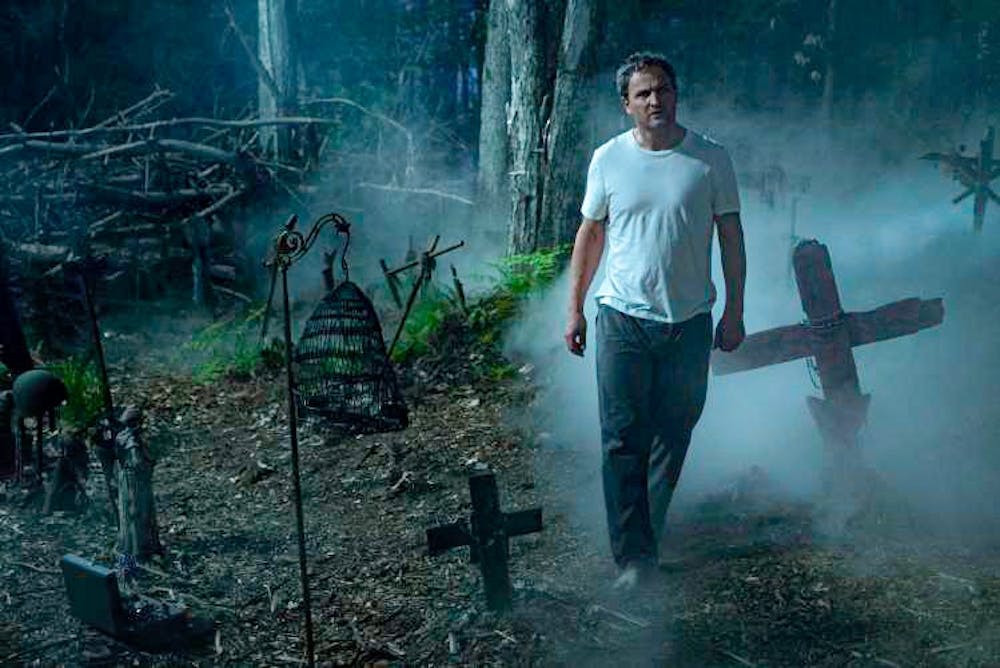“Pet Sematary,” continues the critical revival of Stephen King film adaptations, but fails to reach the heights of “It” and “1922.”
The movie begins with the Creed family— husband Louis Creed (Jason Clark), wife Rachel Creed (Amy Seimetz), daughter Elle Creed (Jete Laurence) and son Gabe Creed (Hugo Lavoie), moving from Boston to the small town of Ludlow, Maine. The house is idyllic and situated on fifty acres of pristine Maine wilderness, yet comes with a catch: there is a highway frequented by speeding, and often out of control, semis just off of their driveway.
Shortly after moving in, Rachel and Ellie explore the property and come across an unnerving procession of kids adorning paganistic animal masks disappearing into their backyard. The girls come to discover, from their neighbor, Jud Crandall (John Lithgow) that a pet cemetery, noticeably misspelled as “sematary,” is located on their property. Crandall explains that local kids have been using the “sematary” since he was a child, and from there a sense of dread grew.
The Creed family’s beloved cat, Church, falls victim to one of the portended semi trucks. Louis, a doctor by trade and someone who holds an admirably rationalistic interpretation of death, buries the cat with the help of Jud. They proceed to the “pet sematary,” until Jud has a change of heart and leads Louis to a supernatural burial ground. Church returns the next day to Louis’ astonishment, setting off a chain of events that leads to climax of knives and jump scares.
“Pet Sematary” suffers from an overabundance of jump scares, but manages to develop an unnerving atmosphere. This atmosphere continues nearly until the end, before coming undone by a predictable and mundane execution of its climax. The promise of the first two-thirds of the movie tragically deflates in a clumsy final act.
Jason Clark gives a competent performance as Louis Creed. The talent of Clark is wasted by the directors reluctance to develop Louis any further than a grieving father. The only character development that is on display is through Rachel Creed. We come to learn about her traumatic childhood and the motives of her actions in the movie. Seimetz gives a convincing and commanding performance, but is sparingly used.
John Lithgow is perfectly cast as a sincere, but misguided Jud Crandall. Lithgow is warm and empathetic, and can claim his performance as a late career highlight.
Kolsch and Widmyer’s adaptation, despite a few worthy scares, finds itself on the weaker end of Stephen King adaptations. It is often clumsy and loses King’s innate sense of developing dread through story.
The success of Andres Muschietti’s “It” and Zak Hilditch’s “1922” has renewed enthusiasm for Stephen King adaptations. Muschietti’s 2016 adaptation of “It,” was a phenomenon, beloved by both fans and critics. It benefited from Muschietti’s adept grasp of storytelling and memorable performances. This was followed by Hilditch’s critically well-received adaptation of “1922.” Kolsch and Widmyer’s “Pet Sematary,” continues the critical revival of Stephen King film adaptations, but fails to reach the heights of “It” and “1922.”
The renewed focus on the maestro of literary horror has been accompanied by a noticeable increase of quality in horror movies. The first wave of Stephen King adaptations boasts horror classics that include Brian De Palma’s iconic adaptation of “Carrie” and Stanley Kubrick’s idiosyncratic,“The Shining.” De Palma’s “Carrie” was by no means short of gore, but the startling imagery was elevated by De Palma’s investment into the abused girl.
We empathize with the abused and bullied Carrie White (Sissy Spacek), and when she finally loses control, instead of fear, we feel an overwhelming sense of pity for the girl. Kubrick drew the ire of Stephen King with his adaptation of “The Shining.” The adaptation often feels distant and cold, but the artistic talent on display overcomes the narrative shortcomings. Kubrick had no need for jump scares, rather the atmosphere that he slowly and confidently developed throughout the movie exploded into a memorable display of an unleashed Jack Nicholson.
“Pet Sematary” falls short of the superior Stephen King screen adaptations, but manages to hold its own as a passable entry into the horror genre. Hopefully, this is the low point of welcomed resurgence of Stephen King adaptations.
Get content from The Daily Lobo delivered to your inbox
Justin Schatz is a freelance reporter and photographer for the Daily Lobo. He can be contacted by email at culture@dailylobo.com or on Twitter @JustinSchatz10.






